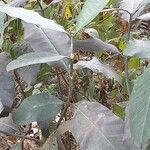Corolla white, sometimes pale yellow, with a pale green tube and often with a pale yellow throat, thickly carnose, in the mature bud with a ventricose tube and a comparatively small blunt broadly ovoid head formed by the lobes (being about 1/5 of the whole length of the bud), outside puberulous only on the bud covered part and there mostly only at the base, rarely entirely glabrous, inside from 0–3 mm. above the base and reaching to 0–2 mm. below the insertion of the stamens with an incomplete (interrupted at the centre of the anthers) belt of soft short downward pointing hairs, between the insertion of the stamens and the mouth densely to (sometimes) sparsely pilose, above the mouth pubescent up to 0·3–0·6(1) times the length of the lobes; tube 3–5(6) times as long as the calyx, 18–35(42) mm. long, almost cylindrical, 5-angular, at the base 4–8 mm., ventricose at the insertion of the stamens or barely below and there 8–13 mm., above 5–10 mm. wide, not or (especially at the base) slightly twisted (up to 1/4 turn); lobes usually more or less falcate, 0·7–1·6 times as long as the tube, 1·5–4 times as long as wide, 14–50 x 6–18(27) mm., rounded, not auriculate, undulate.
Leaves petiolate; petiole glabrous, 6–19 mm. long; lamina coriaceous (also when fresh), variable in size, broadly to narrowly elliptic, 1·3–3 times as long as wide, 10–50 x 5–26 cm., with the apex acuminate, acute, or in some leaves rounded, rounded or cuneate at the base, entire, with a more or less revolute margin, glabrous on both surfaces; secondary veins 7–16 on each side of the midrib, rather straight at the base and gradually upcurved, forming an angle of 60–80° with the midrib.
Pistil glabrous, 15–20 mm. long; ovary almost cylindrical, 3–5 x 3–4 x 3–4 mm.; style 7–10 x 0·8–1·4 mm., slightly widened at the apex; clavuncula almost cylindrical, 3–4·5 mm, long, laterally obscurely 5-angular and at the base widened into a 2–3·5 mm. wide ring, in the middle 1·2–1·5 mm. in diam., at the apex widened and with 5 subcircular lobes altogether 1·5–2 mm. wide; stigma 0·3–1 mm. long, obtuse or acute.
Sepals pale to medium green, almost free, thick, carnose, erect, subcircular or ovate, 0·8–1·4 times as long as wide, 4–7 x 4–7 mm., imbricate in bud, entire, ciliate, glabrous outside, inside with 1–3 dense rows of small colleters closely together in the middle of the base.
Mericarps pale glaucous, often dotted, obliquely subglobose, 7 x 6 x 6–15 x 13 x 14 cm., rounded, with an indented line of dehiscence, but probably indehiscent, several-to many-seeded; wall on section and inside white, 2–4 cm. thick; aril white.
A small tree. The leaves are opposite and broadly oval. They are 30 cm long by 13 cm wide. The fruit are large. They are round and in pairs. They are 10 cm across. They have a hard thick skin and many seeds.
Seeds dark brown, dull, 11–14 x 5–6·5 x 4–5·7 mm., with longitudinal grooves, with a minute honeycomb-like structure covered by pale brown minute deciduous warts.
Stamens barely to up to 12 mm. included, inserted 1/4-1/2 the length from the base of the corolla tube, being 8–14 mm.; anthers 9–13 x 4–5 mm,, glabrous.
Inflorescences mostly long-pedunculate, suberect, 8–26 x 5–15 cm., few-to many-flowered, fairly lax.
Bark pale brown or grey-brown, shallowly to deeply longitudinally fissured, with large lenticels.
Bracts scale-like, much smaller than the sepals, with a single row of colleters in the axils.
Branches pale brown, with large lenticels, with conspicuous leaf scars; branchlets glabrous.
Shrub or small tree 2–18 m. high, trunk terete, 4–40 cm. in diam.
Peduncle glabrous, 3–14 cm. long, fairly robust.
Flowers sweet-scented, open in day time.
Pedicels glabrous, 8–22 mm. long.
Ovules c. 100 in each carpel.





